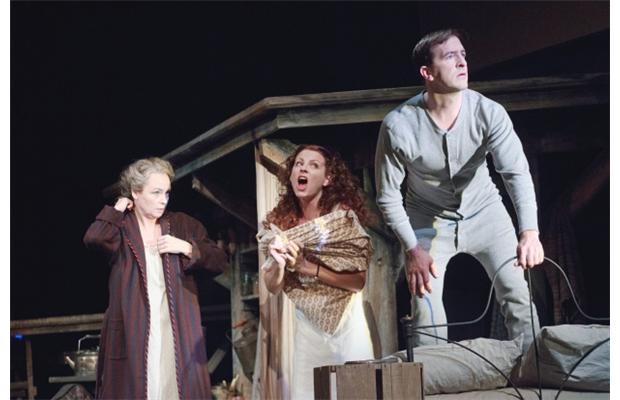
The Glace Bay Miners’s Museum: Subdued Moral Passion Avoids the Perils of Melodramatic Excess
How well has Wendy Lill’s 1996 play about a now-vanished mining culture worn? Well, that depends on how you perceive it.
> It’s easy to dismiss it as no more than a period piece with little relevance to the present. Or to protest the lack of epic dimension to this examination of a company-controlled mining community in 1940s Cape Breton. Or to attack it for failing to be in a more experimental post-realist mode. > The play, based on a Sheldon Currie story, has triggered debate — and, in some quarters, hostility from the very beginning. And there will always be controversy over the climax which sees the intrepid but psychologically ravaged Margaret MacNeil revealing the grisly contents of the personal “museum” she has created as a memorial to those she has loved — and as an indictment of a world which in many ways has become a prison for those who exist in it.
> The play, based on a Sheldon Currie story, has triggered debate — and, in some quarters, hostility from the very beginning. And there will always be controversy over the climax which sees the intrepid but psychologically ravaged Margaret MacNeil revealing the grisly contents of the personal “museum” she has created as a memorial to those she has loved — and as an indictment of a world which in many ways has become a prison for those who exist in it.
> It is a play tinged with moral passion, but it’s subdued in this co-production by the National Arts Centre and Halifax’s Neptune Theatre. And with good reason. Director Mary Vingoe, who was also responsible for the play’s original East Coast production back in the 1990s, appreciates the perils of melodramatic excess, a condition which Lill’s play sometimes invites.
> The Glace Bay Miners Museum is, of course, a memory play in which Margaret, the feisty daughter of a mining family, tells us her story of tragedy and — curiously — triumph, of how a charming larger-than-life, bagpipe-playing troubadour named Neil Currie saunters into the life of herself and her family, ends up her husband following a charmingly depicted wooing scene, and ultimately becomes a victim of the pits because it’s the only work he can find.
> The play is certainly an indictment of the system by a writer who has served as a New Democrat MP in the Canadian Parliament. But Mary Vingoe’s production sees it, not as a piece of polemic, but as something more subtle. The Glace Bay Miners Museum emerges here as more of a quietly pensive tone poem — an attempt to evoke a particular time, place and culture by showing — through the nuances and minutiae of daily life — its devastating impact on one struggling, beleaguered family.
> Working on designer Sue LePage’s expressive multi-levelled set, the cast is largely successful in serving this vision of the play. As the doomed Neil Currie, Gil Garratt may not be the greatest singer or fiddler but he still delivers the evening’s stand-out performance as the confidence and charisma of this character’s early scenes yield to a brave but desperate vulnerability.
> Garratt’s characterization travels a clear arc which is less the case when it comes to Francine Deschepper’s performance as Margaret. There’s much to admire in this actress’s work here. Her Margaret is unsentimentalized but resilient: more to the point, there’s a tart humour in her portrayal, a quality which enlivens her scenes with Neil. But while the play certainly makes us aware of the appalling events which lead to Margaret’s breakdown and the dreadful consequences, Deschepper has trouble tracing her character’s own psychological journey into mental illness. Because the text doesn’t provide enough for her to work with, we more or less have to take accept Margaret’s decline as a given.
> Jeff Schwager does the best he can with the underwritten role of Margaret’s brother, the dedicated young union member obsessed with hardship in the mines. Again, the script seems problematic. Martha Irving as the embittered widowed mother, for whom life has been no more than one hard struggle, struggles to make this woman more than just a stereotype but often becomes simply mannered.
> The play owes a lot to director Mary Vingoe. Which is why, in its own understated way, the production repeatedly seizes one’s attention. This is no more evident than in the wonderful work of David Francis as the grandfather whose damaged lungs make speaking an agony: this veteran actor shows how silence can emerge as the most eloquent of dramatic statements.